*Sigh*. Just when my confidence in NAPIT needed a shot in the arm, they go and shoot themselves in the foot...
I get called out to a fair few kitchen, bathroom, loft conversion and extension installations where the electrics have been badly modified and remedial work is needed to put things right, and when I ask for the certification to see who did the dirty deed, it’s funny how often I hear the homeowner say they never received such paperwork because the installer was a bathroom/kitchen fitter or a builder, and not an electrician.
The fact is, any work you have done which involves any modifications to your electrical installation should be certified by the person performing the work, or someone overseeing them, and they should be appropriately skilled to have taken the job on. Just because someone happens to be a builder or a bathroom/kitchen fitter by trade doesn’t make them somehow exempt from this. If your bathroom installer says “I’ve put new downlights into your bathroom but I can’t certify the work because I’m not an electrician”, then he shouldn’t have bally well buggered about with the lighting in the first place! If he isn’t willing to accept the responsibility for the ongoing safety of the modifications he has made, and if he hasn’t checked to ensure the circuit he modified was fit for purpose before starting, then how can you know it has been done properly and will be safe in the long term? If the installer isn’t specifically trained, qualified and armed with the requisite test equipment and familiarity with electrical regulatory requirements, then what on earth are they doing dicking around with your electrics in your home?
Oh sure, they might be able to cobble together something that works, but is it safe? Can it be trusted in the event of a fault? Has it been installed in such a way that it won’t degrade or affect other aspects of the installation? I’ve seen electric cables tied to copper hot water pipes, earth bonding cables removed for being in the way, undersized cables installed, circuits cross connected, structural joists cut out to make way for downlights, cables burning from proximity to hot lamps, smoke alarms rendered ineffective by obsticles or ventilation equipment and all manner of other no-no’s botched into place by builders and fitters who aren’t necessarily being deliberately unscrupulous, but are certainly ignorant of how to approach the job. While their modifications may well operate correctly on the face of it, it’s when a fault occurs that you’ll suddenly find yourself in trouble because the water pipe which isn’t earthed is now live, or the wiring is burning because it can’t handle a short circuit current, or your freezer is defrosting because the RCD has tripped and won’t click back on, or your smoke alarm isn't waking you up in a fire. By that time, the installer is long gone with your money in his pocket and you’re the one left with the defrosted freezer, if you’re lucky, or the electrocuted child or burned out house if you’re not.
An electrical certificate passes the legal liability for the safety of any electrical alterations onto the installer whose signature appears on the paperwork. If you don’t have this paperwork, then the legal liability rests with you as the homeowner for failing to be able to prove you appointed the appropriate person for the job. Electrical fire through bad workmanship? Good luck getting your insurance to pay up if you can’t prove the work was performed and signed off by a proper electrician. Non-compliance with the Building Regulations? It’s you facing a fine and the costs of putting right if you can’t prove the work was performed and signed off by a proper electrician. Injury through electric shock or death by electrocution? It’s you facing a potential prison sentence if you can’t prove the work was performed and signed off by a proper electrician.
And that’s the value of certification for the homeowner. It should give you the confidence that your installer has done the job right because their signature on the paperwork means they face the insurance costs and the legal heat should something subsequently go wrong. It should force the installer to ensure their work is performed to the highest standard to reduce the risk of them being liable for an incident or accident and it absolves you of responsibility by proving you performed your due diligence when hiring the right person to perform the work. It should also give you peace of mind that the work has been done properly and is less likely to inconvenience you through a messy death by shock or fire.
Sure, DIY is cheaper, your mate from down the pub who says “electrics is piss” is cheaper, and perhaps your bathroom fitter can take on the required alterations cheaper, but without that signature confirming it was all done to a British Standard by a professional, you’re the one who is out on a limb accepting all the risk.
Now, there’s no law to say you have to have electrical work performed by an actual electrician, and maybe you’re confident enough in your own abilities or in those of your appointed builder/fitter for the work to be done without certification. It’s not illegal, but the liability and the risk rests with you, and it’s okay if you’re willing to accept that.
The interesting thing about electrical certification is that I often see certs which are riddled with errors and omissions such as the one I detailed in Cowboy Competition #4, but that doesn’t always matter. If the installer has signed the certificate, then they have landed themselves with the liability. They may have to explain the cock-ups on their paperwork should they end up in legal trouble for whatever reason, and errors or omissions on their paperwork will count against them as under Regulation 29 of the Electricity at Work Act (1989) they will have to prove they were sufficiently skilled to undertake the work, which would be a difficult defence if they’ve made schoolboy errors on the paperwork, but even a bad certificate has value for the homeowner. If the homeowner can say they appointed Acme Electrical Ltd. to perform the work, and ACME Electrical appears to be a proper accredited outfit who then sign off the work as being compliant with BS7671 (the IET Wiring Regulations), then even if that signed certificate is choc-full of nonsense mistakes, the homeowner still has ‘em by the short and curlies and has absolved themselves of responsibility for any consequences.
So, with that in mind, I’m always surprised by installers who are so ready to sign off work that they must know isn’t right or that they can't have had any real involvement in.
That’s not to say an electrician can’t work with a third party. They may be happy for the builder to perform the basics such as chasing walls and pulling in the cables, but if the electrician is to sign off on the final certificate, then they need to be involved from the beginning in the design and then the ongoing inspection/testing as the job progresses. Simply turning up on the last day when the cables are concealed behind final finishes is no good because they can't see what lurks out of sight.
If I’m signing off an installation where a third party has been involved, whether it’s a labourer, a subbie or a partner firm, I want to be damn sure the job has been done right, and the only way I can do that is to be involved from the start. It’s my name and my reputation at risk if I negligently throw my signature out there for any old builder or DIY’er who wants a quick sign-off on their work in exchange for a brown envelope filled with cash. I won't do it unless I'm in on the ground floor where we have a plan, I can test and inspect wiring before it is covered up, and I can verify it was the job progresses.
What we have coming up in this article is evidence of an installation where the sparky wasn’t involved from the start, and in fact he doesn’t appear to have been involved much at all, yet he has still certified the modifications made to an installation and has run it though NAPIT, whom he is accredited with, for the Part-P Building Regulations Compliance Certificate.
So, pull up some popcorn and let’s see what he’s done and what NAPIT think of the matter....
First, let me give you the history. The homeowners shelled out thousands of pounds to Homebase for a new kitchen at their home in Milton Keynes. Homebase appointed one of their approved kitchen fitters to undertake the work, and to my knowledge the kitchen fitter appointed the sparky who is also based in MK and is accredited with NAPIT.
Eventually the work would see the following electrical modifications:
A single fluorescent light replaced with a downlight arrangement taken from the existing ground floor lighting circuit already serving the kitchen. The kitchen lighting already had two way switching between the back door and the kitchen entrance.
Plinth lights would be installed on three separate non-contiguous worktop sections.
Undercupboard lights would be installed on one worktop section around the hob.
A new socket circuit would be installed around the hob worktop area.
An existing socket circuit would be modified with new accessories and relocated outlets.
The old cooker circuit would be repurposed to operate two ovens.
A new circuit would be installed to serve an electric hob.
The property has a metal Amendment 3 consumer unit which was installed a few months earlier in November 2015. The installation and certification of the new CU was undertaken by a different electrician who certified and notified the work and was not involved in the subsequent kitchen alterations. The old kitchen was stripped out and the walls/ceiling largely replastered, so there was a blank canvas to play with.
Towards the end of the refit, the homeowners could see for themselves that the quality of workmanship for the electrical alterations was lacking and they were concerned enough to contact both NAPIT and Homebase. The latter offered to send in an independent NICEIC accredited sparky to assess the situation, however the person they nominated wasn’t accredited with NICEIC for inspection work.
Some web trawling by the homeowners caused them to come across my website and although it's out of my usual area, they called me in to perform an independent inspection and to provide a condition report on the quality of the work which, as we shall see, was rather poor. I was later asked to right the wrongs, or at least as many of them as was possible without ripping out the final finishes.
It’s a shame that the electrician who certified this job wasn’t involved from the start as there are a couple of silly things on this installation that could and should have been avoided had a bit of thought gone into the planning. Take the three sets of plinth lights installed in this kitchen; here they are all separately fed and switched which is stupid. Who wants to hit three switches located in different parts of the kitchen to operate the plinth lights? It wouldn’t have taken much for them to have all been run off a single driver with a single 3A fuse from a single switch fed from the lighting circuit and operated alongside the switch for the overhead lights. Instead, one fused spur had been installed adjacent to the light switch for one set of plinth lights, another fused spur by the sink for a second set and the third set was controlled by a light switch located by the back door. The first two operated from the socket circuit, and each had a 13A fuse by the way, while the last one was off the lighting circuit and was unfused.
That’s a careless lack of planning which makes for a scrappy final installation and you wouldn't expect a detail like that to be missed on a £25k kitchen. A couple of DC cables run in at the very beginning would have tied these lights together and eliminated the daftness, but look at how the drivers for them have been installed:
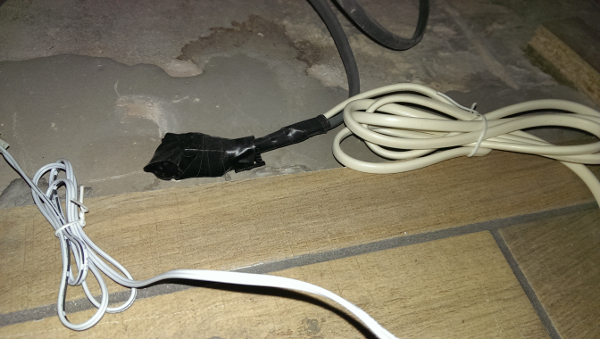
Yes, it’s our old friend Mr ChocBlock wrapped in electrical tape. Sure, it works, but it’s unprofessional. If I was shelling out for an accredited sparky on an expensive kitchen refurb, I wouldn’t want to see this kind of crappy DIY-effort. The lack of correct fusing to the manufacturers' instructions sets the installer foul of Regulation 134.1.1.
There was also a lack of planning for the socket circuits. Personally, I’d have preferred to have pulled in a whole new circuit for the kitchen/utility and left the old socket circuit serving the rest of the ground floor, but what we have here are all the kitchen/utility sockets running from the old ground floor ring, then a new ring installed to serve just three outlets located around the hob, one of which is on top of the cupboards and is only for powering the cooker hood.
This means you have to be careful if you have the need to isolate the socket outlets in the kitchen, as flicking the breaker labelled as ‘kitchen sockets’ will only take out the three outlets around the hob while the rest remain powered. I also wouldn’t have bothered installing these three outlets in a ring configuration. Personally, I’m not a fan of rings – they're a post-war throwback not seen much outside of the UK and in my opinion they’re for the ‘old boys and the cowboys’ – those who have been doing the job forever and stick with what they know, or those who think sockets have to be connected as a ring because they don’t sufficiently know what they’re doing.
That's a controversial viewpoint many sparkies wouldn't agree with, and there’s nothing wrong with rings as such, but they require extra testing, they’re more of a pain in the arse to repair or modify, and if there’s a break in the ring then all the sockets will keep on working so you won’t know about it and you run the risk of overloading the cable. Personally, I prefer to run in 20A or 32A radials, albeit more of them sometimes.
Each to their own, but for a poxy three socket outlets, one of which only serves a 3A cooker hood, I’d have put it in as a 20A radial on 2.5mm2 cable, or if 32A was really required then I’d have installed a 4mm2 cable. Why bother to ring the thing for so few outlets all located in the same small footprint?
But, the thing with this ring is that it was connected to a 32A breaker at the consumer unit, however the breaker was not labelled and was left stuck into the ON position with electrical tape!
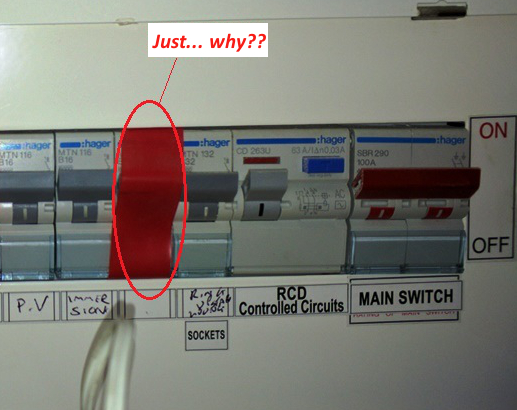
Baffling isn’t it? Remember a NAPIT sparky has signed off that he installed this new circuit, but then hasn’t labelled it at the board and has left the protective device taped ON so that if it needs to trip it may not be able to mechanically do so!
In later written correspondence with the homeownwer where the electrician was asked about this, he responed to say "The breakers taped off are no longer in use, they would be taped in the 'off' position and as such constitute no fire risk. You can remove the tape if you wish." Well we can see above that the breaker is very much taped in the ON position, and we know it is not unused because a new circuit, one he has supposedly installed and signed off, utilises this breaker. Even if it were spare, why tape it up at all? What's the point?
Let’s also question why the metal knockout boxes on the new accessories lack earthing tails...
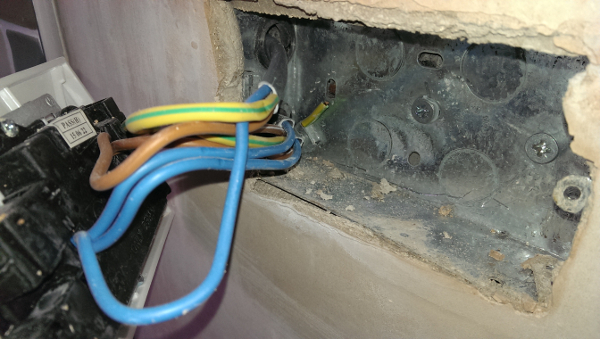
In fact, let’s question why the socket pictured above did once have an earthing tail, but it was cut off (you can still see what's left). Probably evidence of an old knockout box being re-employed. Regulation 411.3.1.1 requires all exposed conductive parts to be connected to a protective conductor and knockout boxes aren't included in this as..., well..., they're not normally exposed and are normally earthed via the accessory screws which, so long as there is at least one fixed lug, means you don't have to run an earth tail to the box. However, although you are supposed to safely isolate any accessories before removing them, you can't guarantee the homeowner or someone else will do so, so in my opinion it's good practice and more professional to always put in an earthing tail. It's not like they cost anything - I rip open offcut flex and nab the CPC conductor out of it for my toolbox!
Incidentally, the socket pictured is interesting as it has been moved horizontally from its original position which has now been plastered over. What’s the betting that the connection behind the plaster is more choc-blocks covered in insulation tape? It also now places the feed cables which run from ceiling level to the old location out of a prescribed zone, so you’d better be careful when drilling or nailing into that wall to put up shelves or pictures! There is another interesting point about this socket, but it will come up later after we’ve looked at the paperwork.
One last word on the sockets, the installer/fitter found the dryer cable too short to reach the new sockets they had mounted into an undersink cupboard, so their resolution was to use an extension lead....
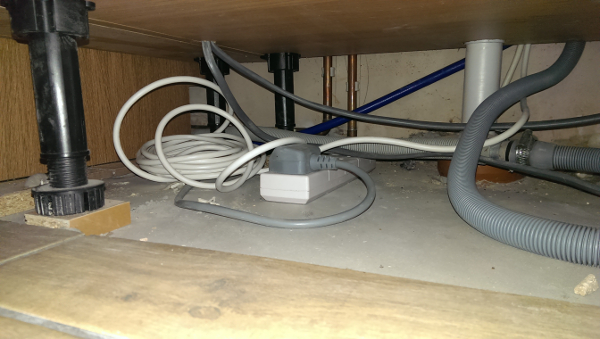
Now that’s a sorry-ass solution if ever I saw one. They couldn’t even be bothered to shorten the lead length even though it had a removable plug (and I pesume they know how to wire a plug)! Notice its proximity with a plastic water pipe union. Any leaks down there will soon see the RCD tripping in short order. But really, what kind of kitchen fitter can't plan for a socket point to be placed in an accessible location where an appliance is to be sited? Remember folks, this is supposedly a £25k kitchen!
Let’s move on to the lighting. During my inspection it was found that the two-way switching for the kitchen overhead lights no longer worked. The switch by the back door had to be in a certain position in order for the switch by the kitchen entrance to operate. This was existing wiring which had been working before, so it’s just a schoolboy cock-up made by the installer when he's fitted the new decorative light switches and it looks like this...
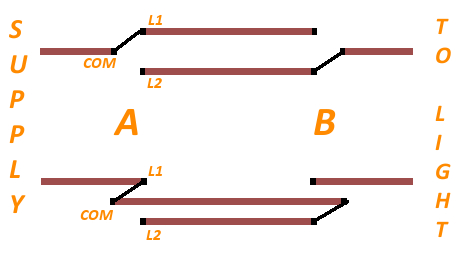
The upper switching arrangement shows how the circuit was originally wired when the house was built and has the supply passing through switch A, across strappers L1 & L2 to switch B, then out to the light fitting. The light can be controlled via either switch when wired in this way.
In the lower switching arrangement, some dufus has miswired the new switches and ended up moving one strapper to the COMmon terminal while the supply and light are now each connected to the L1 terminals in switch A and B respectively. In this arrangement, switch B will still control the light, but only if switch A is in the L1 position. If switch A is flicked into the L2 position, then the lights will be turned off if they were on, but switch B will be unable to turn them back on.
I'm told the homeowner mentioned the switching issue to the installer and was advised that it couldn’t be corrected. It could of course, and I unbotched it during my initial inspection; but here's how I found the wiring looking behind switch A when I first removed the faceplate...
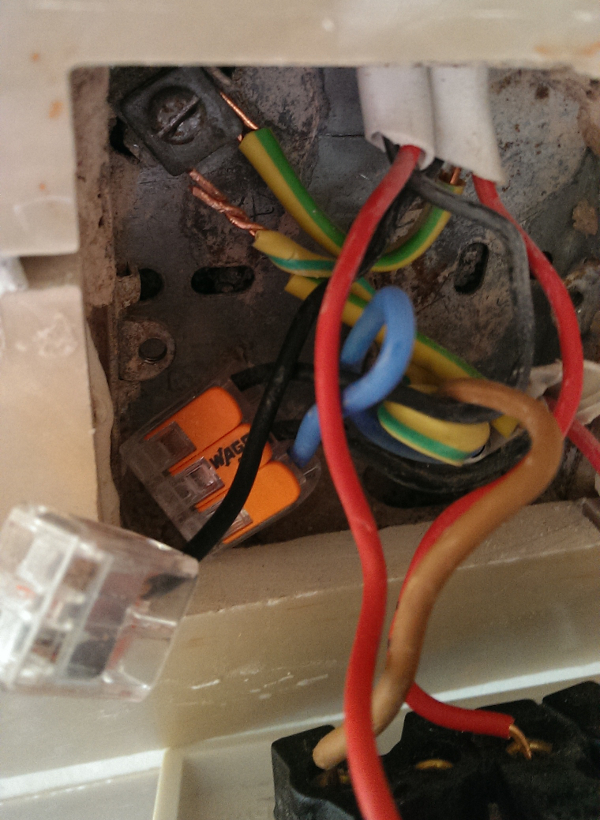
It's a mess. Two protective conductors have come loose from the lug on the knockout box, some cores aren't sleeved to indicate their correct function and there’s too much copper showing on the line wire going into one of those switch terminals. This is not to a professional standard.
Besides the switching snafu, those new downlights aren’t installed too cleverly either as some are too close to the joists with chunks chopped out of them to accommodate the aesthetic arrangement.
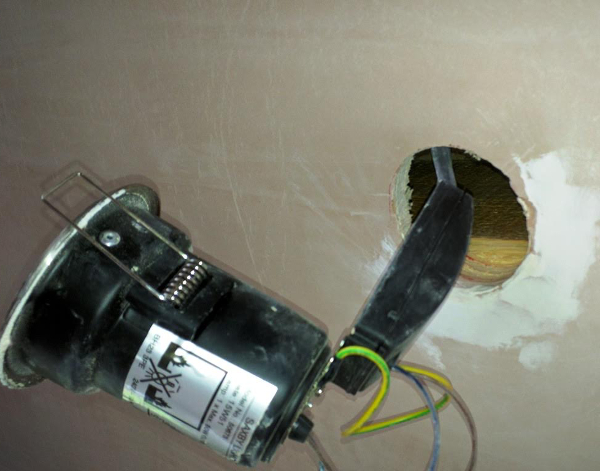
If you’re cutting out structural elements to make something look pretty, then you’re not complying with the Building Regulations. Still, at least they are fire rated this time unlike in Cowboy Competition 4.
Moving on to the ovens and hob, the former running from an existing cooker circuit, the latter on a new circuit. Two ovens from one cooker circuit - nowt wrong with that, but the junction has once again been made with choc-blocks and tape and isn’t of a professional standard.
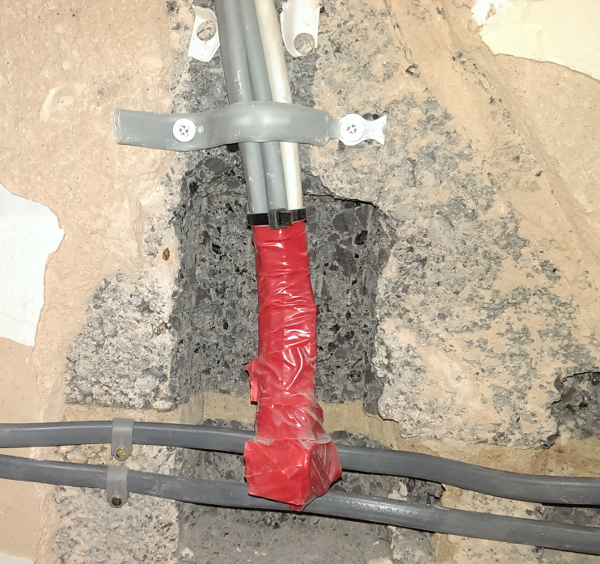
The hob is interesting as a 32A MCB has been used and feeds a 6mm2 cable, but the hob wiring looks like this...
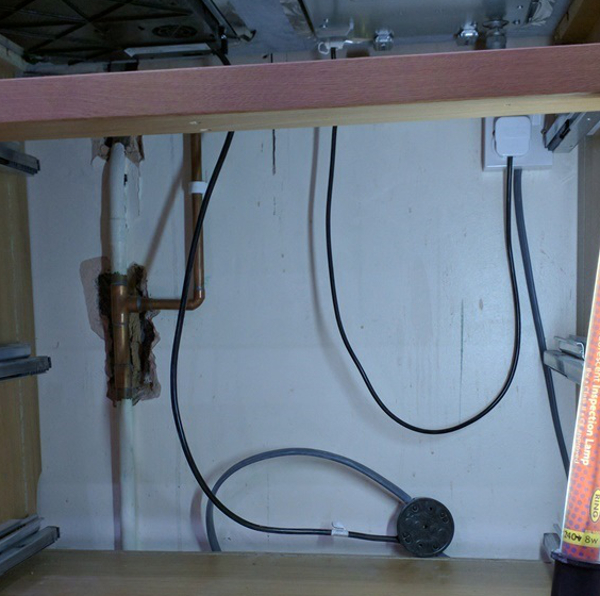
Pulling out that floating junction box for further inspection...
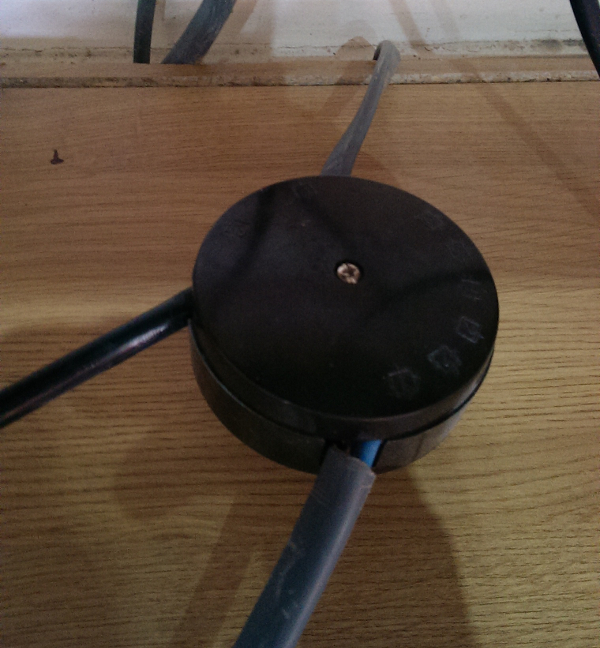
Sure, a 32A feed through a 6mm2 cable is all well and good, but the junction box hanging on the end of it is rated at 20A, and the two cables coming out of it are 2.5mm2 – one is the flex for the electric hob itself, the other goes to a socket outlet to supply an ignitor for a secondary gas hob. If the electric hob ever goes faulty and pulls a short circuit current, that 2.5mm2 flex will burn long before the 32A MCB operates. The rating of the electric hob is such that a 16A or 20A MCB would have been correct for the job. Notice too that the outer sheath of the 6mm2 cable doesn’t quite enter the enclosure of the junction box, and just why is the whole thing floating n’ flapping around when it could be secured to the wall as required by Regulation 522.8.5?
Incidentally, the isolator for this hob circuit was wired in backwards, so the input was on the output side which resulted in its neon indicator illuminating regardless of whether it was switched on or off. The cheapest, crappiest isolator had been employed and it required replacement as it wasn’t mechanically switching properly anyway.
Just to add insult to injury, the hob and oven circuit labels had been transposed on the consumer unit, so the two circuits were misidentified.
Staying with the consumer unit, I mentioned earlier that it was a metal Amendment 3 board, so I was horrified to find upon opening it that the screw which electrically connects the earth bar to the metal casing was loose. I can’t say I’m a fan of metal consumer units as a badly installed one is no less safe than a badly installed plastic one in my opinion, but now I have the risk of shock whenever I open one up because of the conductive enclosure not being earthed properly with goodness knows what kind of botched wiring contained within.
We also have the issue here that the metal enclosure has been cut to allow new cables to pass through, but no edging or grommet has been installed so the cables are exposed to the sharp edges.
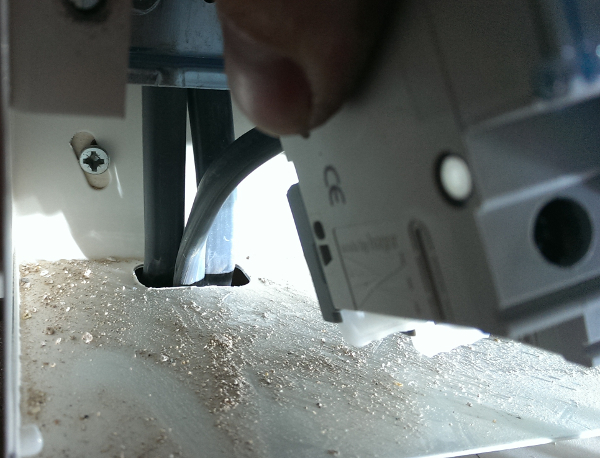
Finally I’m going to mention the undercupboard lighting, because the top of the cupboards looks like this:
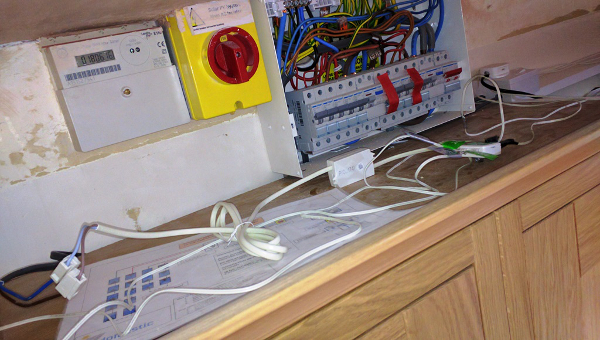
Again, does this mess look like the standard of work you’d expect from a professional installer? I guess he ran out of electrical tape by this point as this time he hasn’t even wrapped the junction to the left where the transformer connects to the supply wiring leaving the brown and blue cores exposed in defiance of Regulation 526.8. We also have Band I (Extra Low Voltage : 12V DC in this case) mixed up with Band II (Low Voltage : 230V AC) cables which contravenes Regulation 528.1.8.
Hopefully we’re all agreed that what we’ve seen here lacks the professionalism in workmanship expected of a £25k kitchen remodelling performed by a bona-fide NAPIT electrician on behalf of a major high street chain. Let’s take a look at the paperwork and see what we’ve got signing off this shit-show...
The homeowner originally received the following certificates...

This is a minor works certificate and I’ve put orange splodges next to the bits I don’t like.
Certificate reference – Well, where is it? Surely the installer has a numbering system for his own referral? How do we know this certificate has actually been filed or recorded in any way if it lacks a unique reference number?
Description of minor works: "Cooker circuit" – This installation has two ‘cooker circuits’, the original one which now serves two ovens, and a new one which serves the hob. Which does this relate to? Both circuits have been modified and require some kind of certification, but the new hob circuit requires an Electrical Installation Certificate, not a Minor Works certificate, yet no EIC has been received.
Insulation Resistance – listed on here as ‘Essential Tests’ under the Section 3 heading, yet spun off as N/A. Of course these tests are applicable, and slapping N/A into the boxes is not an option.
Signature – The missing signature along with the missing certificate reference makes this appear as lip-service; simply thrown out to appease the homeowner, but not actually officially recorded anywhere. No signature and no reference means no transfer of liability, so if things ever got legal this installer could claim the cert was a fake and that he never actually issued it.
Let's look at the next one which refers to the installation of recessed downlights...
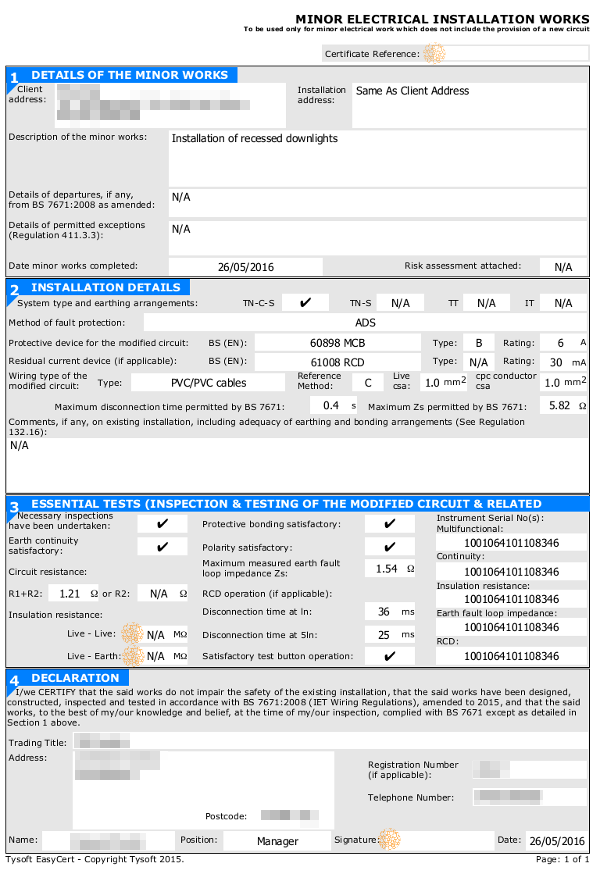
This time a Minor Works is the right kind of certificate, but this one has all the same omissions as as before and therefore also lacks validity.
The worrying thing about the new downlights is that the insulation resistance testing performed as part of my inspection gave a very low reading – 0.14MΩ between line conductors and earth. Regulation 612.3.2 states the minimum passable reading is 1MΩ, although anything below 2MΩ requires investigation. According to the certification from the consumer unit change a few months earlier, the test result then was listed as <20MΩ which is... strange. I’m not sure why that installer gave a vague value rather than an absolute one; surely his tester recorded a specific reading, but it does indicate this circuit had a lower than expected IR before the kitchen alterations began. Ideally the IR result would be off-scale high – that’s 299MΩ on my Megger or 500MΩ on my Fluke, so while a value of less than twenty, and presumably higher than one, would have been acceptable for the new downlights, it is nonetheless perhaps an indication of something on that circuit going bad. Maybe the insulation has been damaged somewhere by overheating, over-bending, crushing, nicks, knocks, water ingress, rodent damage or whatever.
The trouble now is that I don’t know if the iffy 0.14MΩ IR reading was this bad before the downlights were installed, or if it is now this bad as a result of the downlight installation. Our installer didn’t record any IR readings on his certificates despite his own paperwork showing them as ‘Essential Tests’. If the reading was this low before he started work, he should have investigated the issue before modifying the circuit because it has a pre-existing fault making any alterations uncertifiable. If the circuit tested out healthily beforehand but not so after the downlights had been installed, then he needs to check how his work has compromised the integrity of the circuit. Either way he’s certified something which has a fault and doesn’t comply with Regulation 612.3.2 and he has conveniently omitted the test data from his paperwork which would have shown this non-compliance.
Here is the third and final certificate as originally issued, and again this is a Minor Works covering additions and alterations to the socket outlets....

...however we know some of the original sockets have been moved around, hence the need for a Minor Works cert on those, but also a whole new socket ring has been installed to serve three(!) outlets around the hob, so this new circuit should be subject to a full Electrical Installation Certificate and not a Minor Works. Which circuit does the above certificate actually cover? Well, probably the old one seeing as the Zs reading is given as 0.66 Ohms which indicates a circuit larger than the three-outlet ring it's supposed to be covering, but it isn’t clear. Again it suffers from all the same omissions seen previously making it not worth the paper it’s printed on in hardcopy form or even the bytes it takes up on your hard drive if you’re of a PDF bent!
It didn’t require me to tell the homeowners that they were getting stiffed on quality though, and they had already complained to NAPIT long before I got involved. NAPIT prodded the sparky whose name was on the job and he came back to the homeowner saying...
“..It has also been brought to my attention that I have issued you with a minor works certificate for the hob and ring main circuits which should have been electrical installation certificates, this is an oversight and I apologize [sic] for this. I have attached a copy of the correct documents to this email.”.

Wait.. he... issued the wrong kind of certificate? But... how? How can a professional get it wrong? BS7671 only lists three model forms: two certificates - the Minor Works Certificate and the Electrical Installation Certificate, and one report (EICR), and its quite clear which form relates to what kind of work. A Minor Works, as its name suggests, is for minor additions and alterations to an existing circuit, while an Electrical Installation Certificate is for any new circuits or other major installation work such as the replacement of a new consumer unit. Even on his own certificates under the Minor Electrical Installation Works heading, it states "To be used for minor electrical work which does not include the provision of a new circuit". Two wholly new circuits have been installed here, so an Electrical Installation Certificate is due. Anyone working in the field who doesn’t understand something as basic as that should be hanging up their toolbelt.
So okay, I’ll suspend my disbelief just long enough to review the hastily issued Electrical Installation Certificate which apparently now does cover those new hob and socket circuits. Let's take it one step at a time...
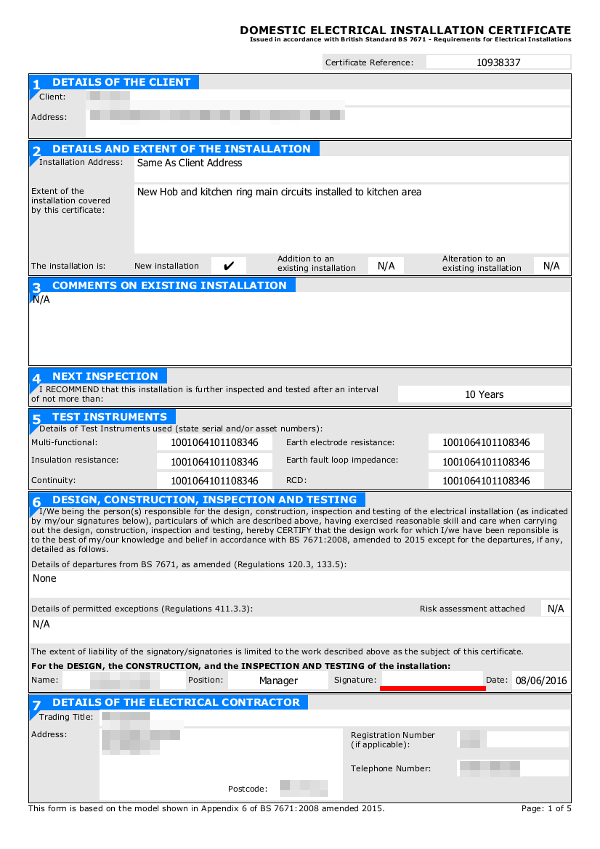
Although we do have a certificate reference this time, presumably in case NAPIT start poking around, there is still no signature. This chap is using a certification software package called EasyCert which allows him to import his signature electronically so that it can be applied to the certificates he creates. If he lacks the skill or wherewithal to do this, and it should be said that EasyCert will provide him with technical assistance upon purchase, then he should print hard copies of the paperwork and sign it old-school style with a biro. As stated earlier, no signature means the paperwork lacks validity and the certificate has not been completed as per the requirements of BS7671. Appendix 6 of the Wiring Regulations specifically states that the certificate “...should be made out and signed or otherwise authenticated by a skilled person or persons..” Regulation 631.4 requires a certificate “...be compiled and signed or otherwise authenticated by skilled persons, competent to verify that the requirements of the Standard have been met”. Regulation 631.5 says that for certificates “...their authenticity and integrity shall be verified.” So no signature and, to a lesser extent, no certificate reference, leaves this paperwork invalid for the purpose for which it was intended.
Moving on to page two...
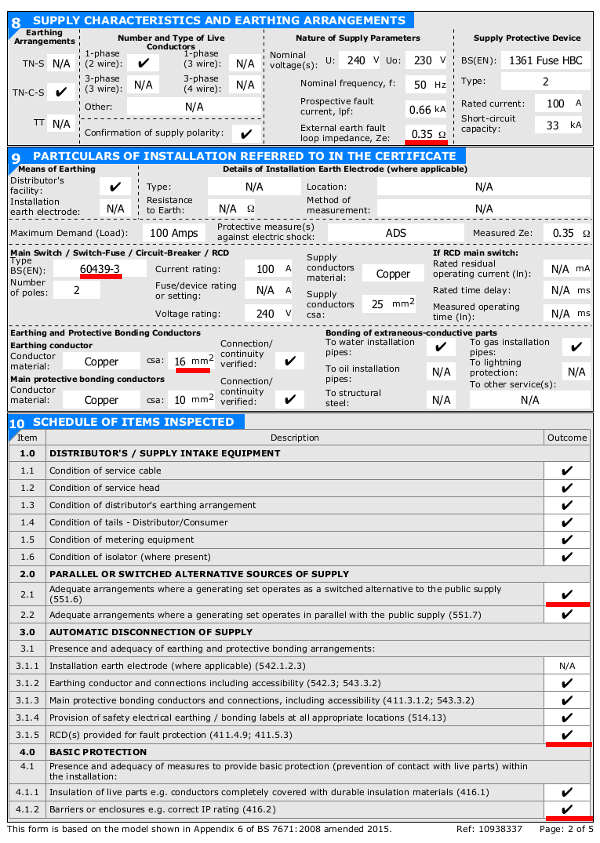
Let’s start at the top with Supply Characteristics and Installation Particulars before we get bogged down by the checklist. The first item I’ve underlined is the External Earth Fault Loop Impedance (Ze) as he has listed it as 0.35Ω. This is a TNC-S (PME) installation so 0.35Ω is the highest value it is allowed to be. This part of the certificate can be completed by measurement or enquiry, although if you phone the District Network Operator and enquire of the Ze for that particular installation, the DNO drone-on-the-phone won’t have any idea and will just quote you the worst case, i.e. 0.35Ω. Now, I found this installation to have a Ze higher than most, in fact I recorded it at 0.31Ω. It also had a 25mm main earth rather than the usual 16mm, presumably because the Ze was so near to the limit. So, while writing a figure of 0.35Ω on the certificate isn’t wrong, I question it here because in an email to the homeowner that I shall show later, the installer specifically says he performed a Ze test. While it is conceivable that the Ze may fluctuate and different testers will have slightly different readings, going by all we’ve seen I’m not so sure he ever did perform any physical testing on the external earth fault loop impedance on site which is perhaps why a worst-case figure has been noted on the cert. Seeing as he originally “certified” all the work using Minor Works certificates which don’t require a Ze test, I’m guessing he skipped it on the day and it was only when NAPIT told him to knock up an EIC after the fact that he suddenly found he needed a number he didn’t have, so he simply jotted down the highest one he could get away with. That's conjecture of course, but seems to fit.
Moving on, he has the main switch as being to BS(EN)60439-3 which is a valid British Standard for certain switchgear, but isn’t the case here. The main switch in this board is to BS(EN)60947-3 as are most main switches in modern domestic consumer units. He’s probably just selected the wrong drop-down item in EasyCert and failed to spot the error. With NAPIT on his back, you'd think he'd be a little more invested in the proofreading of this one though.
The main earthing conductor has been listed as having a CSA of 16mm2, but the most cursory of glances would visually confirm it as 25mm2, presumably because the external impedance is so close to the limit, the extra conductor thickness is needed to keep the resistance from the intake to the consumer unit as low as possible. If he had just looked at the intake position, then he would have seen the earth conductor is as thick as the 25mm2 tails. He should have noticed this at the consumer unit end because to perform the Ze test correctly he would have had to disconnect this earthing wide-boy and would have clocked the size at that stage if not before. Again, I believe he never did test for Ze on site which is why he hasn't noticed the larger cable size on this installation and has gone on to erroneously report the size on paper.

And so we move on to the checklist, the part of an EIC that is so often not completed correctly. Many iffy electricians simply tick all the boxes, perhaps with the possible exception of the earth electrode one, but for any given installation some items are valid and some are not. The checklist requires either a tick to indicate the listed item is present and correct, or a N/A if it is not applicable. If someone is just going to tick everything without regard to whether it actually applies or not, then that rather defeats the objective and makes the whole thing not worth bothering with.
Looking back to the first page of the checklist, we can see all items are ticked apart from the earth electrode, but there are three items I’ve underlined which are ticked when in fact they're not applicable.
“Adequate arrangements where a generating set operates as a switched alternative to the public supply (551.6)” – this has been ticked, but although this installation has a solar PV generator, it does not operate as a switched alternative to the public supply. Domestic solar PV installations of this size are required under Engineering Recommendation G83/2 to disconnect when the grid supply is lost and not to continue generating power. This is so an engineer up a pylon won’t be fried by somebody’s PV installation back-feeding into the grid when it has been isolated for maintenance or repair. This box would be ticked if a back-up generator was installed as an alternative to the grid supply, but that’s not the case here where the PV operates in conjunction with the grid supply. This box should be N/A.
“RCD(s) provided for fault protection (411.4.9; 411.5.3)” – also ticked, but the RCD’s in use here are for Additional Protection as defined by BS7671. An RCD for fault protection would be when the disconnection time of a protective device such as a fuse or breaker cannot be guaranteed, probably because the earth fault loop impedance is too high such as when earthing is provided by a rod. We know this installation has no earth rod as it has been listed as a TNC-S and the earth rod tickbox is the only one this installer has listed as N/A on this page, so what does he think he’s ticking here?
“Barriers or enclosures e.g. correct IP rating (416.2)” – ticked, but we’ve seen live parts here covered by insulation tape in various places. To me, that is not an effective barrier or enclosure and is unlikely to comply with the requirements of Regulation 416.2.
He's also ticked all the boxes for the condition of the Distributor's / Supply Intake Position, but had he actually looked in the meter box he would have noticed the fuse carrier is cracked and he might have also spotted that 25mm2 main earthing. Again, as he intended to spin this off using Minor Works certificates which don't ask specific questions about the intake position, my suspicion is that never actually took a few seconds to open the meter box and examine what was inside, but even on a Minor Works, Regulation 132.16 specifies no addition or alteration is to be made to an existing installation until it has been ascertained that any existing equipment, including the distributors equipment, along with the earthing & bonding arrangements, have been checked for adequacy. Minor Works or not, he should still have carried out basic checks & inspections and commented on his findings in the Comments on Existing Installation section, but he has listed that too as being "N/A".
Page three...
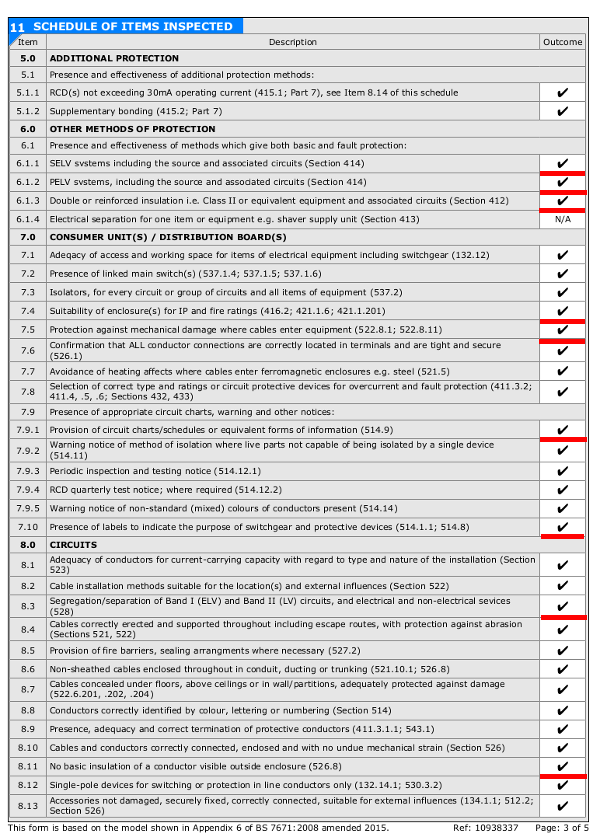
The SELV, PELV and Double Insulation boxes have all been ticked, however none of the circuits installed or modified use these methods as protective measures. Some items of final equipment might well be double insulated or convert the 230V feed down to an extra low voltage, but these tickboxes are concerned with protection for the distribution circuit, not individual elements which may be hanging off it. These boxes are N/A for the work being certified here.
“Suitability of enclosure(s) [consumer unit] for IP and fire ratings (416.2; 421.16; 421.1.201)” – well, the consumer unit did meet the requirement when originally installed, but is now compromised by the holes drilled into it which haven’t been appropriately sealed, so a tick in this box is undeserved.
“Protection against mechanical damage where cables enter equipment (522.8.1; 522.8.11)” – ticked, but no grommets are installed where cables enter the drilled holes in the metal consumer unit, and they’re also missing from some accessories.
“Provision of circuit charts/schedules or equivalent forms of information (514.9)” – ticked, but no circuit listing is provided on the supplied EIC (see later) or on site, and there is confusion as to which circuits the supplied certificates actually relate to.
“Presence of labels to indicate the purpose of switchgear and protective devices (514.1.1; 514.8)” - ticked, but one new circuit at the consumer unit was left unlabelled, and the labels for two other circuits were transposed.
“Segregation/separation of Band I (ELV) and Band II (LV) circuits, and electrical and non-electrical services (528)” – ticked, but Band I and Band II cables were intermingled on top of the kitchen cupboards.
“No basic insulation of a conductor visible outside enclosure (526.8)” – ticked, but the 20A hob junction box and the undercupboard lighting junction both had exposed brown and blue cores. In fact, the latter lacked an enclosure entirely.
Page four...
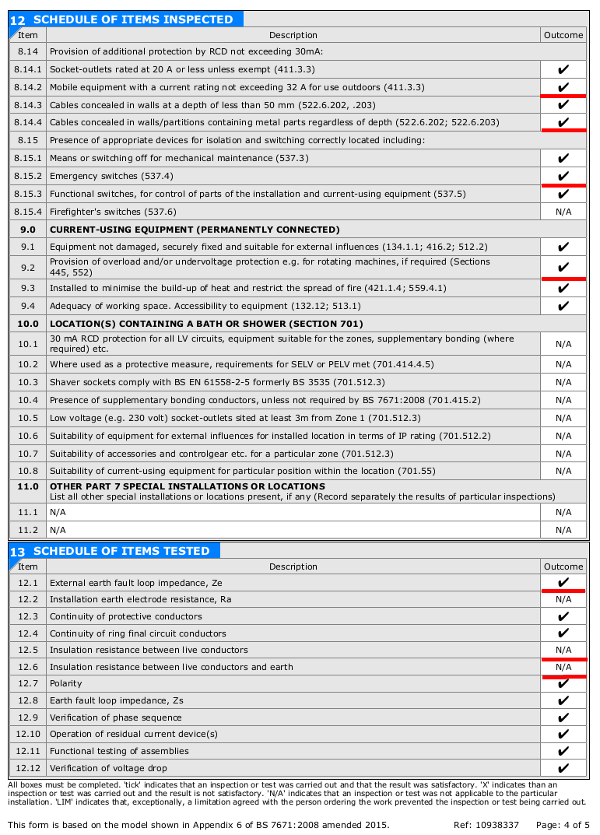
“Mobile equipment with a current rating not exceeding 32A for use outdoors (411.3.3)” – ticked, but this is a kitchen and has nothing to do with equipment outdoors. There’s no external socket or other such feed hanging off it, and while it could be argued that the homeowner might plug in an extension lead and chuck it out the window to power something in the garden, that’s up to them, but it has nothing to do with the fixed wiring installation being certified here.
“Cables concealed in walls / partitions containing metal parts regardless of depth (522.6.202, .203)” – ticked, but not applicable in this brick/block built house. There may be steel RSJ’s above doors and windows, but the wiring drops won’t cross these, at least not as originally constructed.
“Emergency switches (537.4)” – ticked, but where is such exactly? There's an isolator for the hob, but that's just for local isolation and not emergency use as I explained in a previous article. As installed here, it doesn't meet the requirements for emergency switching as defined in Regulation 537.4.2.7 or 537.4.2.6 as it isn't labelled and can't be locked off. There is a lockable isolator on the Solar PV, but that's not subject to this EIC. On this kitchen installation no emergency switches have been installed, so this tickbox is not applicable.
“Provision of overload and/or undervoltage protection e.g. for rotating machines, if required (Sections 445, 552)” – rotating machines? This is a domestic kitchen, not a commercial one and not a workshop either. There are no industrial mixers, pillar drills, lathes, buzzsaws or any other such equipment where a DOL starter or other such hardware may be required, so why is this ticked?
Section 13 on his form is interesting as this is not part of the BS7671 model form and is something EasyCert have thrown in. This is one annoyance I have with third party certification software: the paperwork part of this job is my biggest ballache, so why would I want to spend extra time completing a certificate that adds on additional fields and checkboxes which BS7671 does not ask for? Anyhow, notice he’s ticked Ze as a completed test, although I’ve already cast some doubt on whether that test was actually performed. Again, insulation resistance has been listed as Not Applicable, however it is never not applicable for initial verification of a new circuit as BS7671 lists IR under “Essential Tests” and Regulation 612.1 requires insulation resistance testing to be performed 'where relevant' which it most certainly is here.
Finally, page five, the Schedule of Test Results...

I know it’s been a bit squished in the image above, but let me point out the flaws here...
Firstly, the Circuit Description column. What should happen here is that all circuits are listed, regardless of whether or not they’ve been modified, so that we know what the layout of the consumer unit is and which circuit(s) the Schedule is specifically referring to. What we have here though is something labelled as Circuit 1 Hob and Circuit 2 Kitchen Sockets. Let’s look at the consumer unit in question...
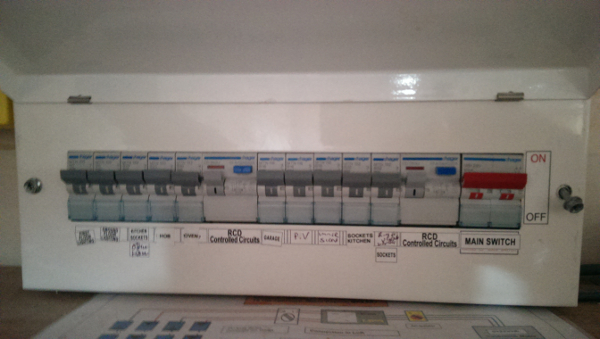
Dammit, I really should check my pictures for focus before wandering off site! Anyway, the circuit listing here is as follows and is numbered right to left from the main switch:
RCD1
Circuit 1: Sockets
Circuit 2: Kitchen Sockets (new circuit)
Circuit 3: Immersion heater
Circuit 4: Solar PV
Circuit 5: Garage feed
RCD2
Circuit 6: Ovens
Circuit 7: Hob (new circuit)
Circuit 8: Sockets (old circuit serving kitchen, hall and study)
Circuit 9: Lighting (ground floor)
Circuit 10: Lighting (first floor)
So, this Schedule of Test Results should relate to circuits 2 and 7 as they’re the completely new ones installed as part of this kitchen refurbishment, yet they’ve been listed as circuits 1 and 2 on the Schedule. Why? Well, I suspect the guy signing it off neglected to take a picture of the consumer unit and didn’t make a note of its layout because he intended to just knock out those Minor Works certificates to make his life easier, and Minor Works certs don't list a board layout. Unfortunately, when he suddenly found NAPIT breathing down his neck for an Electrical Installation Certificate, he realised he had no reference for what was installed where and therefore just listed the two new circuits on their own.
This leaves things a little cocked-up when it comes to “kitchen sockets”. We know there are now two circuits serving the kitchen sockets, the original circuit (circuit 8) which also serves other parts of the ground floor, and the new three-socket ring (pfft!) installed around the hob (circuit 2). This EIC with its Schedule as shown above should relate to circuit 2, the new ring because... well.. it’s a whole new circuit, but the problem here is that the numbers don’t add up. It’s hard to see, but squint at the above Schedule and you’ll notice he has recorded values for r1, rn and r2 on Kitchen Sockets as 0.56, 0.56 and 0.80Ω respectively. These are end-to-end impedance tests, and for 2.5/1.5mm2 cable, my On Site Guide (page 190) reckons that at an ambient temperature of 20C the resistance of a 2.5mm2 wire core should be 7.51m Ω per metre which would indicate a circuit length here of 75 metres.
Does this sound correct for a new ring circuit that is installed on the same wall as the consumer unit and only serves three socket outlets? My own tests during my inspection found readings of 0.50, 0.51 and 0.87 actually applied to circuit 8 which is the original socket circuit that serves the old outlets, and seeing as that circuit also snakes around the hall and study then these numbers probably do indicate a true length of about 66 metres for that circuit.
For our new three-socket ring on circuit 2 however, I recorded readings of 0.07, 0.07 and 0.14 which would equate to a circuit length of just under nine and a half metres which is much more likely considering the layout of these three sockets and their close proximity to the consumer unit.
So, it seems our NAPIT fool has tested the wrong circuit when signing off ‘his’ work. How has this happened? Well, I imagine it’s not his work. In fact, despite claiming three site visits, I don’t think he’s looked too hard at this installation at all before putting his name and reputation, although not his signature, to the paperwork. I reckon that instead of doing the socket testing from the consumer unit, he did it from a socket outlet, and instead of choosing one of the new ring socket outlets, he chose an outlet he thought was new, but unfortunately he chose the relocated socket we looked at earlier with no earthing tail. Sure, this looks new because it has the new wiring colours and is in a new location, but this socket is actually still on the old ground floor ring circuit.
I’m also intrigued by the kitchen sockets listing “number of points served” as six on this Schedule. Number of points served shouldn’t be on a certificate in my opinion. It’s not required on the model Schedule in BS7671, and the term 'point' is open to interpretation. One installer may just count 'endpoints' such as sockets and luminaires, while another may count any device where the wiring breaks out such as junction boxes and switches. Either way, it isn’t helpful because it can’t be relied on as being correct. If you’re looking at an older certificate, you can’t guarantee new points haven't been added, or old ones decommissioned, or that the installer/inspector hasn’t miscounted or made a typo. It can have you scratching your head looking for points that don't exist, or cause someone to get careless when they think they have identified the requisite number of points making them miss additional ones. Case in point here, because that new socket circuit only serves three points, not six as listed. What he has perhaps counted here are the kitchen sockets/spurs being served by the old ground floor socket ring, but that is not what this paperwork is supposed to be certifying and that circuit serves other points elsewhere on the ground floor.
If our sparky was truly involved in the design of the new layout and had been keeping an eye on how it was being installed, then this mistake couldn’t possibly have been made, but seeing as how this new circuit was left unlabelled at the board with the breaker taped up, and the fact he hasn't recognised the numbers don't equate to the circuit length, it seems his brief time on site was just spent performing the most cursory of checks and he really doesn't have a clue what the kitchen fitter has been up to. The fitter has told him a new circuit has gone in, but our sparky doesn't know which outlets it serves or what route the wiring takes and has ended up testing the wrong circuit for his certificate.
r1, rn and r2 have been left blank for the hob on the Schedule, but should be listed as N/A to show the fields aren't blank through omission, while again, the numbers for the socket circuit, including the R1+R2 and Zs values actually relate to the existing ground floor socket circuit and not the shorter new kitchen socket circuit this certificate claims to cover.
Looking at his website, this chap advertises himself as an electrical inspector, however he is not listed as being such with NAPIT which means he likely lacks the qualifications and insurance required for the task. Still, it’s there for the public to see as the following shapshot shows:

So, presumably, when he undertakes an electrical inspection he’d be able to spot signs of trouble such as breakers over-rated for the cables they’re protecting, incorrect labelling of circuits, breaks in circuit protective conductor continuity behind switches, missing earth tails, accessories moved leaving cables outside of prescribed zones, loose connections in the consumer unit, missing glands/grommets, compromised IP rating of consumer unit, insulation resistance below minimum threshold, exposed cores, inadequate connections/enclosures, discrepancies in previous certification paperwork, incorrectly identified cores, basic miswires and all the other things which are in evidence here but which he seems happy to let slide. If he can’t spot all these regulatory non-compliances for the very work he's signing off, and let’s face it, many of the above can be seen visually without any specialist knowledge or equipment other than a screwdriver, then how can he possibly offer inspection services?
I wouldn’t trust this chap to wash my friggin' van based on what we've seen here, let alone have him perform the inspection and testing of an electrical installation, and I wouldn’t be interested in his judgement on whether it’s up to scratch or not as he can’t possibly be qualified to say so, for if he was, he’d be listed with NAPIT as being fit for undertaking inspection work. So let's check his actual listing on the NAPIT website....

Sure enough, under Trades he is not listed as an electrical inspector. At the time of writing I am still with NAPIT so let's see how my listing compares...

The difference from NAPIT's point of view is that I can be legitimately listed as an inspector because I hold specific qualifications for that role and because I have professional indemnity insurance which is there to cover my arse should I ever make a bad call or miss something on an inspection which results in an unfortunate incident. I'm only human (kind of), and I cannot guarantee I'll always be a hundred percent correct, although as my wife knows, I'm rarely wrong. As for this other guy who is out there punting himself as a bona fide inspector to the unsuspecting, well he doesn't make the grade as far as his own accrediting body is concerned, so while money may well be spent by his clients, it's not money well spent for his clients as he hasn't proved himself on paper and probably doesn't hold the insurance cover if he makes a tragic mistake.
Inspections aside, it may well be that he is actually a good electrical installer in his own right, but it seems likely that on this site the kitchen fitter is the one who has performed all the work and this NAPIT sparky has just been hired to quickly and quietly sign it off, only he hasn’t looked too closely at the quality of the kitchen fitter’s efforts, or if he has then he’s chosen to ignore the low standards. It seems he doesn’t know his way around this particular installation as he’s borked the certificates, got the wrong test numbers and doesn’t even have a circuit listing to hand. It seems he’s just interested in pocketing the money without doing the time and putting as many kilometres between him and the homeowner as possible.
That may be easy money, but one day it comes back to bite you on the arse.
In this case, the homeowners had complained to NAPIT before I was involved as they could see the standard of work didn’t match the £25k price tag their kitchen was commanding. In Cowboy Competition 4 we saw how NAPIT refused to right the wrongs of their installer who had failed to notify the work through them, so what about this time now that a complaint was received directly from an end-client regarding a job that had been notified to them and for which the Part-P certificate had already landed with a thud on their doormat?
Well, as we found last time, the NAPIT six-year Work Quality Guarantee only applies if the NAPIT member who performed the work is either dead or out of business. If a NAPIT approved installer makes a dangerous and/or cack-handed mess of your home, then so long as the installer is still in business, NAPIT will require you to invite them back to make good any issues. Otherwise it seems they just don’t want to know.
Of course, by the time you complain to NAPIT about one of their members, the chances are your relationship with the original installer has already completely broken down and you don’t want them back in your home. If you’re going to the trouble of making a complaint, then you’ll be of the opinion that the installer has either botched the job or ripped you off, so why would you want the same guy back, only now with a chip on his shoulder?
In this case, after complaining to NAPIT, the homeowner received this rather terse email directly from our sparky chum:
“I am ****, the electrician who recently carried out electrical installation works in your kitchen. I received a phone call today from Napit, my Part-P registration body, with regards to some very serious allegations regarding the installation work carried out at your property. Apparently you have made accusations that I have issued test certificates for electrical work carried out without visiting the property; I would like to make it very clear that these allegations are completely false. In total I attended your property on THREE separate occasions during the kitchen install, however neither you nor your wife were present at the property during any of these visits, the only occupant I had any contact with was an elderly lady who I presume must be an older relative.
As you have failed to contact me directly regarding your concerns, which would be the normal course of action, I would like to clarify a few points regarding the electrical installation work:
Some of the first fix (running cables, chasing new metal backboxes in) was carried out by the kitchen fitter - ****, this was done under my strict instruction, guidance and supervision and was inspected before any units went in. This installation work fully complies with BS7671 (wiring regulations) and is no different to me using a labourer or apprentice to carry out basic 1st fix work.
All final connections were made by myself on the 2nd visit to the property, including connection to the consumer unit.
On my 3rd visit I carried out final testing, these tests included Earth loop impedance, RCD testing, Ze and PFC testing.
It has also been brought to my attention that I have issued you with a minor works certificate for the hob and ring main circuits which should have been electrical installation certificates, this is an oversight and I apologize [sic] for this.
I have attached a copy of the correct documents to this email.
Once again, this was only brought to my attention during my phone call with the Napit customer services representative and is an oversight on my part which could have been easily rectified had you bothered to contact me. I issue electrical certificates for every job I carry out, this adds up to a lot of paperwork and occasionally mistakes are made.
I believe this entire ruse is actually a petty ploy to try and coerce Homebase into giving you some sort of discount or compensation, I will remind you that I am a Self employed electrician, I work completely independently of Homebase and I do not take kindly to false allegations. All of my work complies fully with the current wiring regulations and Part-P building control. Every effort has been made to ensure the safety and compliance of the electrical work carried out at your property.
If however you do have genuine concerns I am more than happy to visit your property, for a 4th time, to discuss the installation, demonstrate the testing procedures and alleviate any additional concerns you may have.
I hope this settles the matter, if you have any questions please do not hesitate to contact me by phone or email.”
--
Wow. Unbelievable isn’t it?
Wouldn’t it just boil your piss to see work being performed this badly on your expensive new kitchen, and then when you make a legitimate complaint about how poor it clearly is, as per your right, the guy responsible for signing off the mess directly accuses you of being petty to try and get compensation?!
Notice the line which reads "On my 3rd visit I carried out final testing, these tests included Earth loop impedance, RCD testing, Ze and PFC testing." So he claims he did perform the external fault loop impedance (Ze) test, although it seems unlikely to me, but why on the third visit? As already mentioned, Regulation 132.16 states that No addition or alteration, temporary or permanent, shall be made to an existing installation, unless it has been ascertained that the rating and condition of any existing equipment, including that of the distributor, will be adequate for the altered circumstances. Furthermore, the earthing and bonding arrangements, if necessary for the protective measure applied for the safety of the addition or alteration, shall be adequate. So surely on his first visit to site he would have checked the basics such as Ze, PFC, PSCC and earth bonding were all fit and proper before anyone broke out the screwdrivers and started making modifications? What does he think he's doing leaving it until his last visit? If there's a problem, how will he put it right when the final finishes are in?
When confronted with the findings of my inspection as we've rattled through here, he said "Some of your points are valid regarding the certification, some items you have misinterpreted". Oh really? Well if he wants to get into a big-dick competition over the paperwork then I'd be happy to hear of which points I have misinterpreted, but I suspect if his certification and my condition report were forwarded to the likes of NAPIT for review, he'd find his paperwork rather than mine coming up short against their ruler.
As stated, my suspicion is that it's the untrained kitchen fitter who did the work, hence the quality of workmanship which is below standard and the unfamiliarity with the installation that this electrician exhibits with regard to his paperwork, so it's interesting to see him state in writing that he is actually the one responsible for this mess. Personally I doubt he actually spent much time at all on site, but in attempting to cover the his tracks of signing something off that he wasn't really involved with, he's dug a deeper hole for himself by claiming the cack-handedness is actually all his own work, or was performed under his "strict instruction, guidance and supervision", a claim worthy of a slow clap indeed.
Fortunately for the homeowner, their contract was with Homebase, and once Homebase had the results of my inspection along with the hard-to-argue photographic evidence, they allowed the homeowner to have me right as many wrongs as was practical and they picked up the tab.
Places like Homebase subcontract out their installation work, but they require their installers to meet certain requirements and for any subbies the subcontractor subsequently hires to prove they are accredited. I don’t know if this fitter has worked together with this electrician before, but if not he would certainly have been confident that the sparky was up to muster because he is a valid member of NAPIT. What should not have happened here though is that the fitter shouldn’t have been left to perform the wiring work as he is clearly no good at it, while the sparky should have taken a greater involvement to ensure it was being installed to a standard that he could sign off, although he never adequately signed anything off in the end. A lot of money has been spent by the homeowner and seemingly costs have been cut and cash potentially trousered by both the installer undertaking work to an unprofessional standard and the sparky being willing to sign off work he either never saw and only partially tested, or that he simply turned a blind eye to.
Homebase need to speak to their installer and advise him to stop botching other people’s electrics before someone gets hurt. NAPIT need to speak with their member and remind him he isn’t fit to be offering inspection services and ought to brush up on his basic installation, testing and certification procedures. They probably won’t of course.
So, like last time, NAPIT aren't going to do anything about this one because the homeowner, unsurprisingly, doesn't want this gloomy guy back even though he has offered to return, albeit not to make good but to "demonstrate the testing procedures" which will somehow "alleviate any additional concerns" that this installation isn't a cack-handed cock-up despite all the evidence to the contrary. Should you care that NAPIT’s “six-year work quality guarantee” is so flawed? Well yes, because whenever you hire a NAPIT member and they process your job through NAPIT, either because it falls under Part-P of the Building Regulations or because NAPIT’s terms of membership require any domestic work valued at over £250 to be covered by their guarantee, then the cost of enrolment is passed on to you as part of your job.
You’re effectively paying to be enrolled onto a warranty scheme that you won’t be able to use should you believe your installer to be too incompetent to correct the mistakes they probably shouldn’t have made in the first place, or should they turn out to be a threatening, robbing or otherwise unpleasant hairy-arsed thug that you would never want back in your home. If your relationship with your installer breaks down, then so does your warranty with NAPIT. That leaves you high and dry and facing paying out of your own pocket to make good or taking legal action at your own risk, while NAPIT, far from riding to the rescue, join their member by sticking on their ol' ten gallon hats, spitting their chewing tobacco onto your carpet and riding off into the sunset towards the next job. Yeee-ha!
So, here's my advice when looking for someone to make any electrical alterations to your home....
If you’re employing a sparky directly, check the Registered Competent Persons database to see who they're accredited with.
If you’re employing a builder or fitter, ask them who they are using to undertake the electrical work, then look up the person they name on the Registered Competent Persons database. Tell your builder/fitter that you want all relevant electrical certificates and, if applicable, Building Regulations compliance certificates for the work upon completion. Have them agree to that in writing.
If you require inspection and testing work, check the Registered Competent Persons database to see who your chosen sparky is accredited with, then check with the accrediting body, be it NICEIC, NAPIT, Stroma, Elecsa, Select or whoever, via telephone or their website to ensure their member is approved for undertaking inspection work. This requires additional qualifications and insurance that many installaton electricians do not have, yet they still offer the service and might leave you out of pocket with a report that isn’t worth the paper it’s written on as happened in Cowboy Competition #1.
If you believe the installation work you're paying for isn't up to par, and that includes spotting anything wrapped up in electrical tape, then complain to the electrician directly and try to maintain a good working relationship with them. If things start to break down, make a formal complaint to the sparky in writing and give him/her the opportunity to put things right. Should they fail to do so, escalate it to the accrediting body who may, or may not, be of use in sorting things out. Should it all go a bit 'legal' it will stand you in good stead if you can show you gave the appointed electrician every opportunity to resolve the perceived issues. As well as keeping a paper trail of written correspondence, take plenty of photographs of anything you believe looks a bit moody.
When any work is completed, make sure you get those certificates and that they are sporting a signature. Even if the content is nonsense, that signature could keep you out of trouble if push comes to shove.



